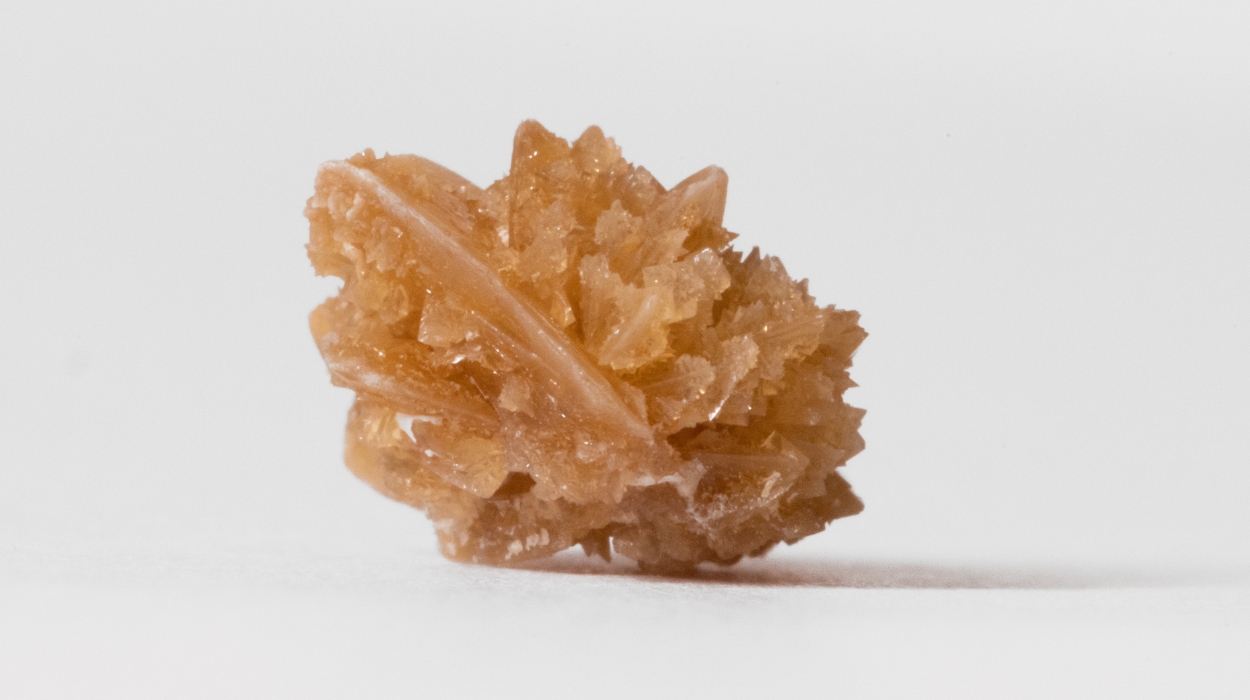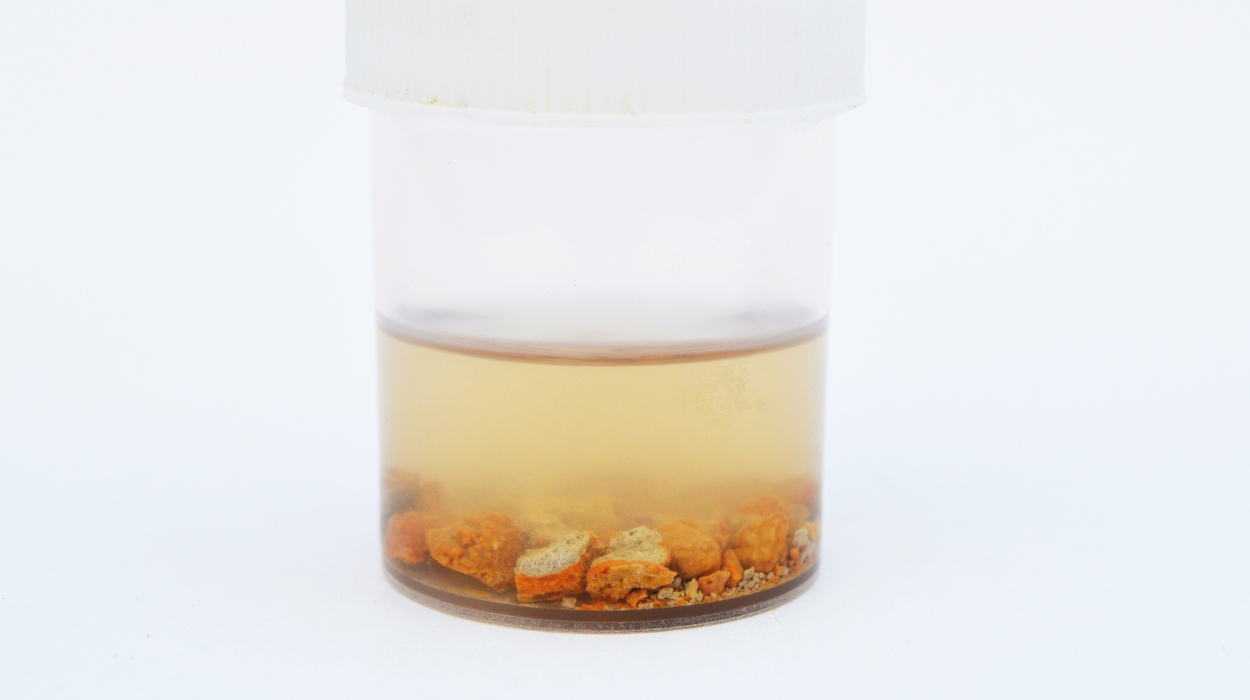 Evidence Based
Evidence Based
Evidence Based
This article is objectively based on relevant scientific literature, written by experienced medical writers, and fact-checked by a team of degreed medical experts.
Our team of registered dietitian nutritionists and licensed medical professionals seek to remain objective and unbiased while preserving the integrity of any scientific debate.
The articles contain evidence-based references from approved scientific sites. The numbers* in parentheses (*1,2,3) will take you to clickable links to our reputable sources.
What Color Is A Kidney Stone? 4 Types You Should Know

Water accounts for 91-96% of the chemical composition of your urine. However, when your urine contains high levels of certain minerals and salts, kidney stones may form in one or both of your kidneys. According to the National Kidney Foundation[1], one in ten people will have a kidney stone at some point in their lives.
Kidney stones, also known as nephroliths or renal calculi, are hard deposits of minerals formed in the kidneys. They can be as small as a grain of sand and as large as a golf ball. Depending on their size and how early they’re diagnosed, they may be symptomatic and cause severe damage to the urinary tract.
To answer the question, “What color is a kidney stone?” The color of a kidney stone depends on its chemical composition. Kidney stones are usually yellow or brown[2]. However, they may also be almost black in some cases.
What Color Is A Kidney Stone?
The color of a kidney stone ranges from yellow to brown to black. This depends on its biochemical composition. A kidney stone can be composed of one or more types of materials. In the case of a mix, the most abundant material determines the color of the kidney stone.
The exact color of a kidney stone can only be determined when it is visualized. This can be done if you accidentally catch the stone while collecting urine or during a surgery to remove the stone, if it has caused an obstruction or is large enough to result in one.
Kidney Stone Colors By Type

There are four types of kidney stones. These are classified based on what they consist of. The minerals that crystallize to form a kidney stone also determine the color of that kidney stone. The different colors of kidney stones, according to their types, are highlighted below.
Calcium Stones
Calcium stones are the most common type of kidney stones, with 65-70% of all renal stones being calcium-based[3]. They are formed from calcium oxalate, calcium phosphate, or both of these calcium salts. Calcium oxalate stones account for 35-70% of calcium stones[4] and are often black or brown in color. Hence, black kidney stones are seen more frequently.
Calcium phosphate stones are less common than stones that have calcium oxalate. They are white in color. Calcium stones can be caused by an underlying disease such as bowel disease or hyperparathyroidism, where there is too much parathyroid hormone in the body, amongst others. At other times, etiology of calcium stones could be idiopathic with an interplay of diet, genetics, and lifestyle habits.
Uric Acid Stones
Uric acid stones are not as common as calcium stones. They account for 10% of kidney stones[5] and occur more in males than females. Uric acid stones are formed when there are high levels of acidic content in the urine that cannot be dissolved in the urine and passed out. Uric acid stones are soft, smooth, and usually brown in color.
Struvite Stones
Struvite stones are the next most common type of renal stone after calcium stones (15%)[6]. They are also known as infection stones because they are formed due to urinary tract infections. These stones mainly contain magnesium and ammonia and are white in color. Struvite stones are larger than other kidney stones.
Cystine Stones
Cystine stones are made up of an amino acid called Cystine. This amino acid is produced in the kidneys, however, cystine stones form when a person has cystinuria. Cystinuria is a genetic disorder passed down through families. When a person has cystinuria, they have high cystine levels in their urine because the amino acid leaks through the kidneys into the urine.
Cystine stones are very rare (2%)[7], challenging to treat and require lifetime therapy. They are yellow or amber-colored and appear more like crystals than stones.
Does The Color Of A Kidney Stone Mean Anything?

The color of a kidney stone shows what it consists of. Hence, the color of a renal stone can reveal several details and information about a person’s health status. It can also determine the different causes of kidney stones. Additionally, it can inform your lifestyle choices and the best measures to prevent kidney stones from recurring later in life.
Diet and nutrition are essential in preventing and getting rid of kidney stones. The best way to prevent kidney stones is to increase the amount of urine you make. This can only happen when you keep yourself hydrated by drinking lots of water and fluids. It is recommended that males and females drink around 13 and 9 cups of water, respectively, in a day. Fluids such as apple cider vinegar and citric fruit juices have also been proven to help prevent and get rid of kidney stones.
Apple cider vinegar (ACV) is one of the most popular home remedies used to reduce the risk of kidney stone formation. Studies prove that apple cider vinegar helps increase urinary citrate excretion, decrease urinary calcium excretion, and increase urine pH levels, all of which are important in preventing stone formation.
Apple cider vinegar is commonly seen its liquid form but it can also be found as a supplement. Apple cider vinegar supplements are available in tablets, capsules, gummies, and in powdered form. Gummies are a more fun, easier, and tastier way to take your supplements and we have our favorite picks of the best apple cider vinegar gummies to take in 2023.
Dietary modifications are significant in getting rid of kidney stones and preventing recurrence. A brown or black kidney stone could mean you have high amounts of calcium. However, it doesn’t mean you should reduce your calcium intake, as low calcium levels increase your risk of developing kidney stones as well[8]. Instead, check with your doctor and if necessary, a dietitian to help draw up a meal plan to meet your dietary needs.
Other dietary measures to reduce calcium stones include:
- Limiting intake of foods high in oxalate, such as spinach, peanuts, beets, and chocolate.
- Limiting consumption of sodium-rich foods.
- Increasing calcium intake.
- Avoiding vitamin C supplements.
- Eating less animal proteins.
Following a healthy diet like the DASH diet[9] can prevent stones. The DASH diet[10] aims to limit meats rich in fat, whole-fat dairy, sugar, and sodium. This diet includes vegetables, whole grains, beans, fish, poultry, fat-free or low-fat dairy, nuts, and fruits. Reducing animal protein intake can eliminate uric acid stones, while low sodium intake can help with cystine stones.
Sometimes, you may require medications to treat stones. For example, potassium citrate tablets may be prescribed to treat small calcium and uric acid stones. Also, your doctor may prescribe medications to treat the underlying medical conditions, such as UTIs, for white struvite stones and cystinuria when your stones are yellow or amber-colored stones.
Conclusion
Kidney stones are common and do not cause severe damage if diagnosed and treated early. Small stones can pass on their own without any intervention. However, a larger stone can cause severe pain and haematuria (blood in the urine) and, in the long run, cause infection and loss of kidney function.
Kidney stones have different colors, depending on what they consist of. They may be yellow, brown, or black. It is important to know what type of stone you have can help determine how to get rid of them and how best to prevent future stones.
Frequently Asked Questions
Kidney stones are common, and about one in ten people[11] will develop kidney stones at some point in their lives.
Men are more likely to develop kidney stones than women. Risk factors of developing kidney stones include not drinking enough water and fluids, losing excess fluids due to sweating and chronic diarrhea, family history of kidney stones, sedentary lifestyle, eating lots of sugary and salty foods, taking certain medicines, and having medical conditions such as high blood pressure, diabetes, cystinuria, hyperparathyroidism, and bowel disease.
Kidney stones can present in different colors. They are usually yellow or brown. However, they may also be almost black in some cases.
Yes, kidney stones can run in families. While genetics do seem to play a role in development of kidney stones, there are other dietary and environmental factors that influence kidney stone disease.
You can develop several kidney stones made up of different materials. Hence, you can have more than one type of kidney stone.
Your healthcare provider will discuss your medical history, perform a physical exam, and order lab and imaging tests. These tests[12] include a CT (computed tomography) scan, abdominal X-rays, blood tests, and urine tests. Other tests may include renal ultrasonography and “KUB x-ray”[13] (kidney-ureter-bladder x-ray).
Your healthcare provider may ask you to take plenty of water to pass the stone. You may be given some medications to reduce the acid in your urine. In cases of urinary tract blockage, infection, or large stones, you may undergo surgery.
Other treatment options include shock-wave lithotripsy[14], ureteroscopy[15], and percutaneous nephrolithotomy/nephrolithotripsy[16] (rare).
Most kidney stones pass on their own and do not require surgery. If your stones need surgical intervention, your healthcare provider will discuss treatment options with you.
+ 16 sources
Health Canal avoids using tertiary references. We have strict sourcing guidelines and rely on peer-reviewed studies, academic researches from medical associations and institutions. To ensure the accuracy of articles in Health Canal, you can read more about the editorial process here
- National Kidney Foundation. (2021). Kidney Stones. [online] Available at: https://www.kidney.org/atoz/content/kidneystones.
- and, D. (2023). Definition & Facts for Kidney Stones. [online] National Institute of Diabetes and Digestive and Kidney Diseases. Available at: https://www.niddk.nih.gov/health-information/urologic-diseases/kidney-stones/definition-facts#:~:text=Kidney%20stones%20may%20be%20smooth,causing%20severe%20pain%20or%20bleeding.
- Ufl.edu. (2023). Kidney Stone Disease: Overview» Kidney Stone Disease» Department of Urology» College of Medicine» University of Florida. [online] Available at: https://urology.ufl.edu/patient-care/stone-disease/.
- Ufl.edu. (2023). Kidney Stone Disease: Overview» Kidney Stone Disease» Department of Urology» College of Medicine» University of Florida. [online] Available at: https://urology.ufl.edu/patient-care/stone-disease/.
- Ufl.edu. (2023). Kidney Stone Disease: Overview» Kidney Stone Disease» Department of Urology» College of Medicine» University of Florida. [online] Available at: https://urology.ufl.edu/patient-care/stone-disease/.
- Ufl.edu. (2023). Kidney Stone Disease: Overview» Kidney Stone Disease» Department of Urology» College of Medicine» University of Florida. [online] Available at: https://urology.ufl.edu/patient-care/stone-disease/.
- Ufl.edu. (2023). Kidney Stone Disease: Overview» Kidney Stone Disease» Department of Urology» College of Medicine» University of Florida. [online] Available at: https://urology.ufl.edu/patient-care/stone-disease/.
- Matteo Bargagli, Ferraro, P., Vittori, M., Pietro Manuel Ferraro, Gambaro, G. and Somani, B.K. (2021). Calcium and Vitamin D Supplementation and Their Association with Kidney Stone Disease: A Narrative Review. [online] 13(12), pp.4363–4363. doi:https://doi.org/10.3390/nu13124363.
- and, D. (2023). Eating, Diet, & Nutrition for Kidney Stones. [online] National Institute of Diabetes and Digestive and Kidney Diseases. Available at: https://www.niddk.nih.gov/health-information/urologic-diseases/kidney-stones/eating-diet-nutrition.
- NHLBI, NIH. (2021). DASH Eating Plan. [online] Available at: https://www.nhlbi.nih.gov/education/dash-eating-plan.
- National Kidney Foundation. (2021). Kidney Stones. [online] Available at: https://www.kidney.org/atoz/content/kidneystones.
- and, D. (2023). Diagnosis of Kidney Stones. [online] National Institute of Diabetes and Digestive and Kidney Diseases. Available at: https://www.niddk.nih.gov/health-information/urologic-diseases/kidney-stones/diagnosis.
- Brisbane, W., Bailey, M. and Sorensen, M. (2016). An overview of kidney stone imaging techniques. [online] 13(11), pp.654–662. doi:https://doi.org/10.1038/nrurol.2016.154.
- Lingeman, J.E., McAteer, J.A., Ehud Gnessin and Evan, A.P. (2009). Shock wave lithotripsy: advances in technology and technique. [online] 6(12), pp.660–670. doi:https://doi.org/10.1038/nrurol.2009.216.
- Lazaros Tzelves, Geraghty, R., Hughes, T., Juliebø-Jones, P. and Somani, B.K. (2023). Innovations in Kidney Stone Removal. [online] Volume 15, pp.131–139. doi:https://doi.org/10.2147/rru.s386844.
- National Kidney Foundation. (2016). Percutaneous Nephrolithotomy / Nephrolithotripsy. [online] Available at: https://www.kidney.org/atoz/content/kidneystones_PNN.



